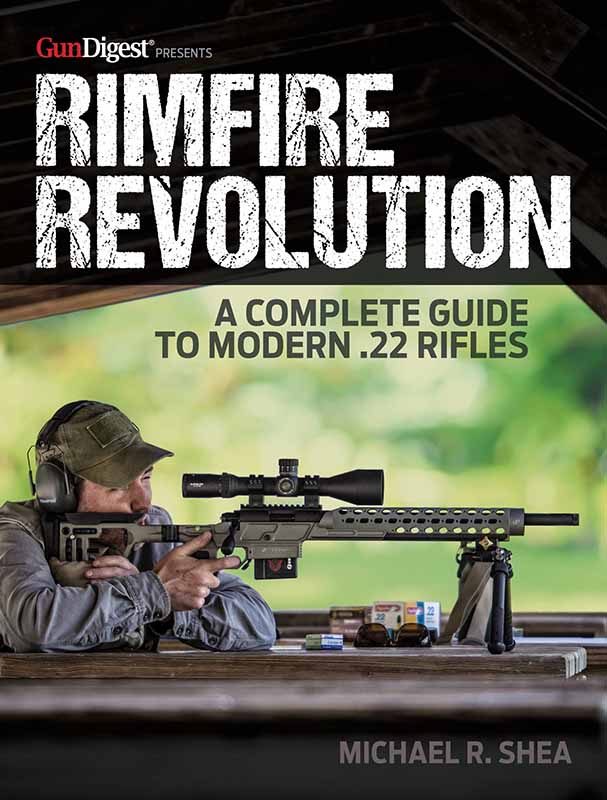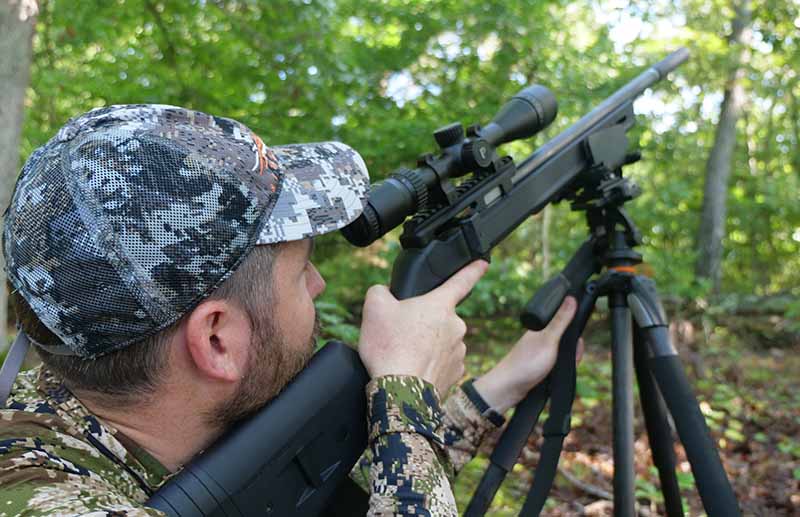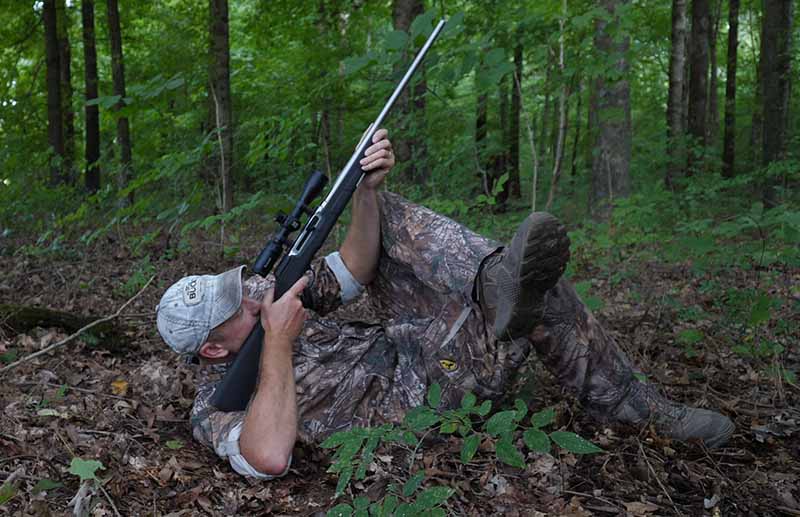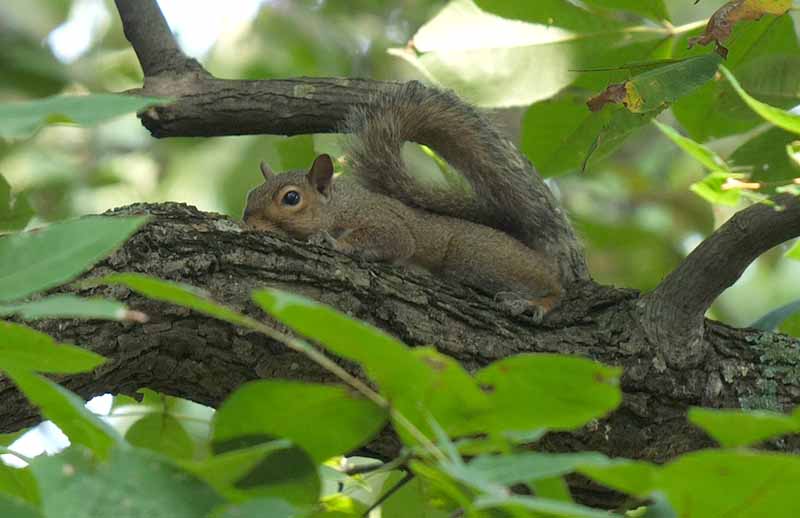
Squirrel hunting is an artform requiring a solid handle on the tools of the trade.
Squirrel Hunting Rifle, Caliber Basics:
- Nearly any sporter style rimfire will suffice.
- Varmint guns work if you have a support, but are better suited for other small game.
- .22 LR reigns supreme for meat hunters, given body shots won't ruin the meat.
- Magnums should be considered calibers for head-shot specialists.

The key difference between competition and hunting is that when target shooting, you know the distance to the target. Or you can use a range finder to range it. Those silhouette turkeys are at 77 meters. This NRL22 course-of-fire has targets at 60 and 90 yards. That squirrel at the top of an old white oak? It's guesswork.
You can use a laser range finder to ping an exact distance, sometimes, but they don't tend to work well through tree branches, and by the time you figure the distance, the squirrel might be gone. When small game hunting, you need to guess distance with a reasonable degree of accuracy, and the flatter the bullet's trajectory, the more wiggle room you have.
For example, if the two-inch kill zone of a squirrel's head is at 75 yards, but you guess it at 50 and use the 50-yard hash in your scope that's zeroed at 25, you will miss that squirrel shooting standard velocity .22LR. With the faster, flatter, .17 Mach 2 you'd smack him in the face. The same smackdown would happen with a .17HMR and .22WMR. Velocity flattens trajectory.

This is the big reason why hunters have largely moved toward high-speed and hyper-speed .22LR loads or the even faster .17s. They help immensely with figuring distance and hold. That all said, nothing trumps developing the skill of accurately calling yardages by sight. It separates the good rifle hunters from the greats. One way to develop this skillset, which I did when I first started bowhunting, is to put a laser ranger finder on a lanyard around your neck when doing yard work. Mowing the grass, ask yourself, How far to that stump? Take a guess, then range it to confirm. With life and hunting, technology and gear go a long way, but there is still no replacement for hard-earned skill craft.
Rimfire Hunting Rifles
Any modern rimfire sporter can make a good squirrel rifle. My Kentucky squirrel hunting buddy Ryan McCafferty lays them down with a Ruger American Rimfire in .22WMR and a cheap Walmart scope that he bought used in a gas station parking lot for $200. The CZ 457 lineup is also excellent, but I'm partial to the thoroughly modern Volquartsen Summit in .17 Mach 2. With the tensioned carbon barrel and Magpul Hunter stock, it's impervious to the elements. The Annie's are shooters, no doubt, but I get irrational when it starts pouring rain on them.

Varmint rifles are heavier. More or less, they're target rifles. The shooting is typically from prone or off a trailered bench. Any modern precision rifle in a hot caliber like .17HMR or .17WSM can work, depending on the expected distance. For varmint like prairie dogs where distances most often exceed 100 yards, nearly all varminters sight-in their rifle at 100 yards, figure the ballistics and drop, and have at it. It's not hard to use a laser range finder and range bands of distance over the prairie, so you know that that spot is about 150 yards, this one is 200, and further back is 250. With a fast, flat-shooting round like a .17WSM, good drop data with a rough known distance can add up to a bloody day in dog town.
For inside 100-yard shooting, like most tree squirrel situations, it gets more complicated.
Squirrel Gun Calibers
A .17HMR or .22WMR, as two of my good squirrel hunting buddies shoot zeroed at 50 yards, will knock the sauce out of a bushy tail at any distance you can see in the timber with your naked eye. The magnums, though, will render a squirrel nearly inedible with a body shot. Anything less than a headshot, and there's typically just too much meat damage to salvage a carcass, or most of it. With the .17 Mach 2, the opposite is true. If you gut shoot a squirrel and the little bullet doesn't connect to bone and explode, you'll lose that squirrel. The squirrel will drop and run or hole up in a hollow and die. For both reasons, the .17s and the magnums are for headshot specialists only.
More Rimfire Info:
- Best .22 Ammo For Every Application
- The .22 LR: Mini, Mighty And Many
- The .22 LR And Its .22 Rimfire Cousins
- Cartridge Debate: .17 HMR vs. .17 WSM
- Ammo: Evolution of the Red-Hot .17 HMR
- The .22 LR For Self Defense: Good, Bad Or Crazy?
In all these cases described, the rifle and optic are effectively set for what's called Maximum Point Blank Range, or for the total distance over which the bullet will travel without flying above or below the vital zone—in this case, a 2-inch squirrel head. Many ballistics calculators let you input a “vital zone radius,” which will let you quickly see the max distance at which a dead-center hold will work. With the app and some knowledge of expected hunting distances, you can tune your zero point, so little mental drop calculation is required in the field.
Maximum Point Blank Range
For .22LR, most small game hunters use a hybrid combination of Maximum Point Blank Range and known drop. With a 50 yard zero, a standard velocity .22LR drops about an inch at 10 yards and about 2 inches around 70 yards. So, for zero to 60 or 65 yards, they'll hold dead-on, then figure out where the corresponding bullet drop is at 70 to 100 or their personal max distance. As mentioned in the chapter on optics, BDC reticles work very well here, especially when keyed to high and hyper-velocity ammunition. That said, sub-sonic to hyper-sonic, round nose or hollow point, the .22LR is a squirrel killing son-of-a-gun. Target loads will knock them flat as fast as hunting loads. The .22LR is loved by so many, too, because it does the job on head and body shots without a gross amount of meat damage. It's also possible to “bark” squirrels with the slow-moving 40-grainers. If a squirrel is lying flat on a tree branch and you can't see enough head or heart to make a killing shot, you can shoot the “bark” of the branch under the squirrel's head. This often creates a concussive wave that kicks the squirrel off the limb, often falling dead. This works with the slow, heavy, solid bullet of a standard velocity .22LR, but not the hyper faster varmint bullets designed to explode on the impact, like the .17s.

Once the zero-point is determined, the final step is to shoot at known distances and look at the actual bullet drop. To do this, pick your zero distance and shoot it, say 50 yards. Next, bring the target into 25 yards. Without adjusting the scope or changing your aim point, shoot another group, holding dead center. Go to 75 yards and 100 and do the same thing. The result will be a single piece of paper with a vertical string of bullet groupings showing your bullet's flight from 25 to 100 yards. Alternatively, you can shoot the same sized bull with the same hold at different distances and line up your targets side to side. This also helps illustrate the rise and fall of the bullet at different distances with a fixed hold.
If you don't like what you see, adjust the zero. Some squirrel hunters zero hyper-velocity .22LRs at 70 or 75 yards as that can still put the little 32-grainers in the kill zone at 15 yards. As you dial in, play with target distances and see what it's doing at 10 yards and 60. My guess is that 99.9 percent of rimfire-shot bushy tails die between 10 and 60 yards. Shoot these distances. Know what your bullet does.
One season, I switched my .17 Mach 2 zero to 50 yards thinking it'd work better. I missed more squirrels up close than all previous seasons combined, so I switched back to King's 25 yards. Adjust and tweak the zero until it works for your setup. Once it works, don't touch it.
Editor's Note:This article is an excerpt from Rimfire Revolution: A Complete Guide to Modern .22 Rifles, available at GunDigestStore.com.

Next Step: Get your FREE Printable Target Pack
Enhance your shooting precision with our 62 MOA Targets, perfect for rifles and handguns. Crafted in collaboration with Storm Tactical for accuracy and versatility.
Subscribe to the Gun Digest email newsletter and get your downloadable target pack sent straight to your inbox. Stay updated with the latest firearms info in the industry.

![Best Concealed Carry Guns In 2025 [Field Tested] Wilson Combat EDC X9S 1](https://gundigest.com/wp-content/uploads/Wilson-Combat-EDC-X9S-1-324x160.jpg)


![Best 9mm Carbine: Affordable PCCs [Tested] Ruger Carbine Shooting](https://gundigest.com/wp-content/uploads/Ruger-Carbine-Shooting-100x70.jpg)
![Best AR-15: Top Options Available Today [Field Tested] Harrington and Richardson PSA XM177E2 feature](https://gundigest.com/wp-content/uploads/Harrington-and-Richardson-PSA-XM177E2-feature-100x70.jpg)

My “squirrel” (and groundhog) rifle is a RUGER 96/22 magnum with an octagonal Green River barrel. That barrel is more accurate than the factory RUGER barrel as in cub MOA at 50 yards. For a lever gun that is very good. Too bad it has a poor trigger that cannot be improved upon. Still, it works great on squirrels with a Bushnell Trophy 4.5 – 7X scope.
Now that I’ve moved from Pennsylvania to Nevada I’ll try it on coyotes using 40 gr. bullets.
40gr, BC .114, 1084 fps
10: -0.87
20: -0.16
30: 0.23
40: 0.29
50: 0.00
60: -0.63
“With a 50 yard zero, a standard velocity .22LR drops about an inch at 10 yards”
Nope.